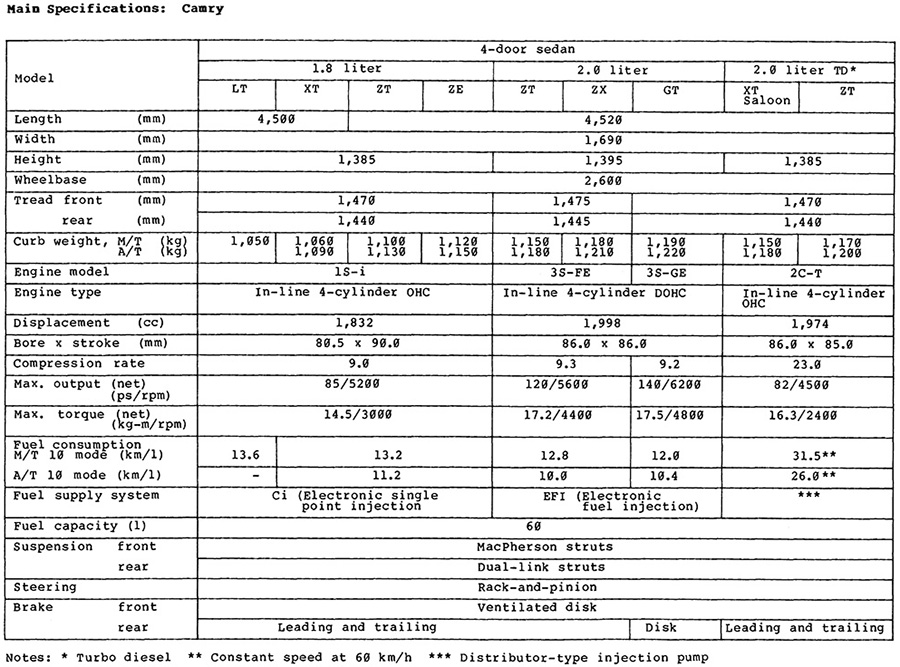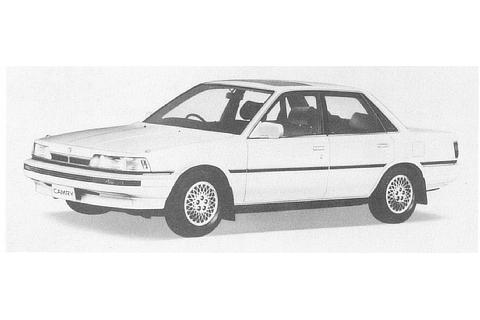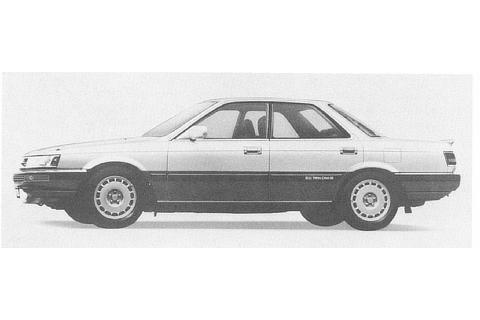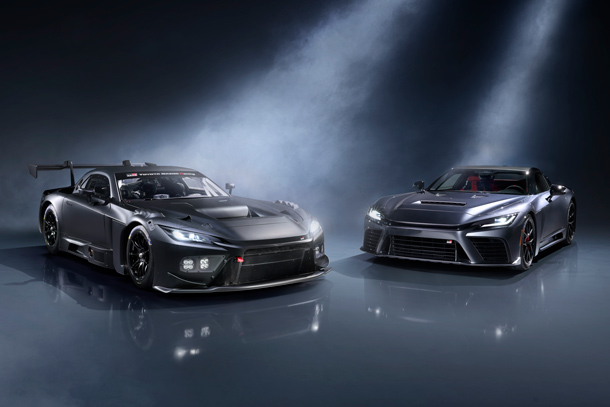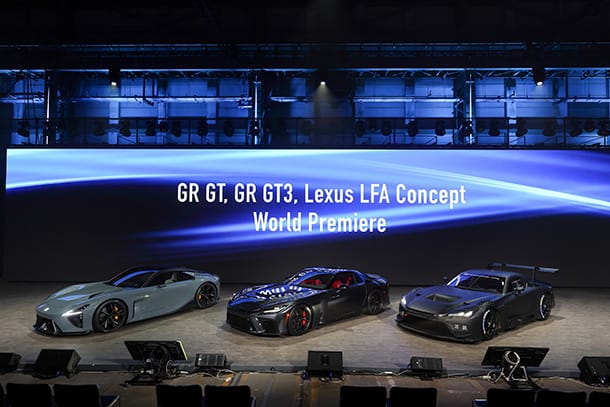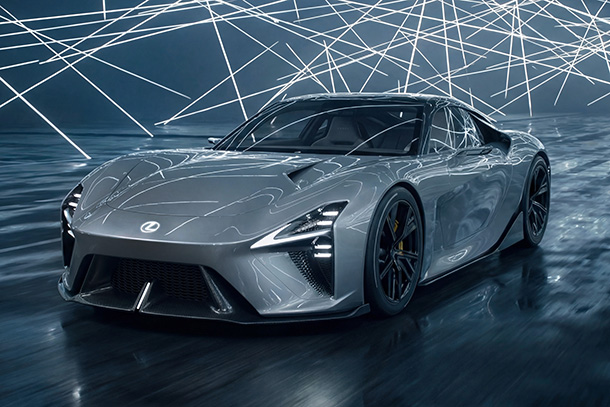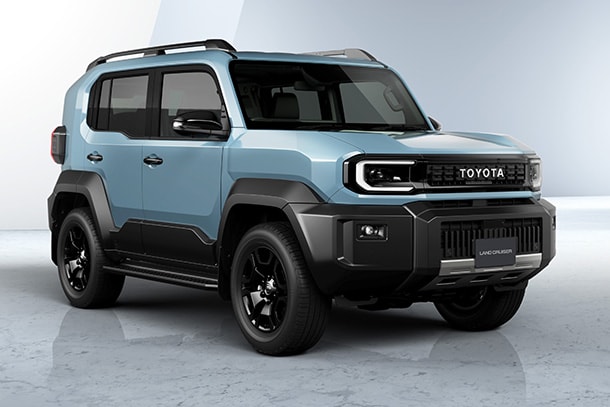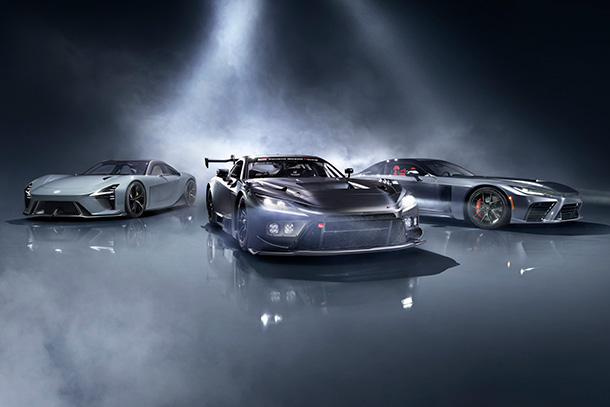Aug. 20, 1986
Toyota Announces All New Vista and CamryQuality FWD Saloon with Newly Developed Twin-Cam Engine 4-Door Hardtop Joins Vista Line-up
Toyota City―TOYOTA MOTOR CORPORATION is introducing full model changes for the vista and Camry passenger cars which go on nationwide sale from today.
-
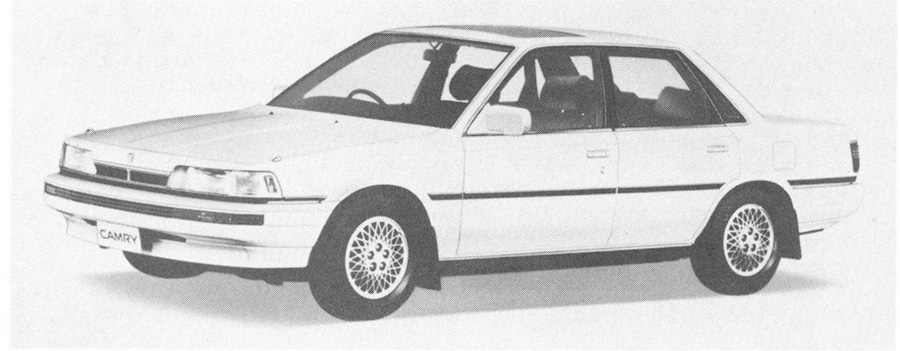
- Camry 4-door sedan 2000ZX
-

- Vista 4-door hardtop 2000GT
The new Vista is available in two body types, a 4-door sedan and a new 4-door hardtop. The body type for the new Camry is a 4-door sedan.
- Exterior styling
The exterior is characterized by aerodynamic styling resulting from totally flush surfaces with carefully tailored corners.
The superior aerodynamics provide a coefficient of drag of 0.33 for the 4-door hardtop with the optional spoiler. The door window frame widths on the sedans have been reduced, and the glass has been fitted as flushly as possible. The result is an enlarged glass area and a flowing body style.
The 4-door sedans have a refined exterior style with gently curving body surfaces, a smooth front end with sharply defined headlamps, and combination tail lamps which highlight the cars' wide look.
The vista's front grille emphasizes horizontal lines, while that of the Camry is a stylized "T" for Toyota.
The combination tail lamps on both the vista and Camry were designed independently to give each vehicle a distinctive look.
The Vista 4-door hardtop has a wide-and-low silhouette: a wide, low front with a simple grille and headlamps with integral fog lamps, and a clean rear with slim combination lamps. The rear window wraps around the sides to envelop the compact looking cabin and complete the car's overall vibrant look.
A choice of nine body colors is offered, including Dark Red Mica, Blue Mica and Super White II.
- Engine
For the new Vista and Camry, two types of 2-liter gasoline engines are available: the newly developed twin-cam 16-valve 3S-FE engine, and the highly popular, high-response twin-cam 16-valve 3S-GE engine. Thus, both 2-liter engines are now twin-cam 16-valve types, providing all Toyota's customers with high-performance twin-cam engines.
Also available for the new vista and Camry are the high-performance, fuel-efficient OHC 1.8-liter lS-i gasoline engine and the OHC 2-liter turbo diesel 2C-T engine.
The newly developed twin-cam 16-valve 3S-FE engine
The newly developed 3S-FE, based on the 2-liter 2S-E, has twin camshafts and four valves per cylinder. Maximum power output has been increased to 120ps at 5,600rpm (JIS net) and maximum torque to 17.2 kg-m at 4,400 (JIS net). For the first time in the world on a car engine, the twin camshafts are connected by a scissors gear. This allows a narrower valve-included angle, which in turn allows a compact design for the combustion chamber. The end result is improved fuel economy, 12.8 km/1 in 10-mode tests (manual transmission), and a light and compact engine.
90% of the maximum torque is available at 2,000rpm. With its maximum power output of 120ps, this twin-cam engine offers optimum performance for daily driving.
- Interior
Taking maximum advantage of FWD, the roomier interior, which has proven very popular with users, has been made even more spacious. The interior space of the new Vista and Camry is 30mm longer and 10mm wider than that of previous models.
The interior design is, in a word, refined. Fully formed door trim has been adopted for all models and blends naturally with the instrument panel.
The instrument panel has been designed with special attention to driving comfort and convenience. Switches that are used repeatedly or for emergency use are located near the steering wheel. In addition, most switches have their own illumination.
An adjustable seat belt anchor for the front seats lets the anchor position slide up and down. This allows the seat belt to fit better, regardless of the size of the driver or passenger.
The rear seats have a 60/40 split-folding feature, allowing full or partial extension of the trunk space, depending on the number of passengers and the amount of luggage.
With the sedan models, the trunk opening comes down to the level of the bumper, making loading and unloading much easier.
- Chassis
In order to meet the improved speed and power output of the engine, the current independent suspension has undergone major modification. The geometry has been improved and most of the parts have been newly designed, making the new Vista and Camry more maneuverable, stable and comfortable.
The front employs MacPherson struts with a stabilizer and strut bar. The handling, stability and riding comfort have been enhanced by optimizing the geometry of the suspension and wheel alignment and improving rigidity through a newly adopted lower brace.
The rear is independently sprung with dual-link struts.
The arrangement of the suspension arms, the length of the lower arms and component parts have all been improved. Vibration and noise have been reduced by connecting the lower arms by way of the subframe.
Progressive power steering is available. In progressive power steering, the power assistance is strongest while the car remains stationary, and decreases in proportion to the increase in speed of the car.
The new vista and Camry GTs also offer the following new features:
- The front strut towers on both sides are joined by a performance rod. This enhances the body's rigidity and improves the car's steering response.
- Toyota Electronic Modulated Suspension (TEMS) is offered as an option. in TEMS, a CPU automatically matches the damping effect of the shock absorbers to running conditions, assuring optimum comfort, handling and running stability.
Tires and Brakes
The new vista and Camry with 3S-GE engines are provided with 195/60R15 tires and 4-wheel disk brakes, while those with 3S-FE engines come with 185/70SR14 tires.
These tires provide better stability and more responsive steering and braking.
Automatic Transmission
In response to the recent increase in the number of customers who desire easier driving, the 4-speed automatic with 2-way overdrive is available for all models.
For the new Vista and Camry with twin-cam engines, the electronically controlled, 4-speed, fully automatic transmission (ECT-S) is now available. The driver can choose from three transmission patterns―"economy," "power" and "manual"―depending on his preference and running conditions.
Models with lS-i and 2C-T engines are available with a 4-speed fully automatic transmission with 2-way overdrive, offering superior fuel economy and driveability.
- Noise and Others
- Engine noise and vibration have been reduced by adoption of the five-point engine mounting and by enlarging the mounts on both ends of the transversely mounted engine.
- The vibration and noise of the body have been reduced by increasing the rigidity of the total structure and by using new materials with vibration-reducing or noise-absorbing/screening properties for the floor and the dashboard.
- The difference in level between the body and glass surfaces has been decreased to 4mm, and the quality of the door seals has been enhanced. These improvements lower wind noise and provide better aerodynamic characteristics.
- Improved rust-proofing includes:1) the use of rustproof steel sheets for sections that most often come in contact with the elements, and 2) more extensive use of a polyvinyl chloride (PVC) coating on the underbody.


